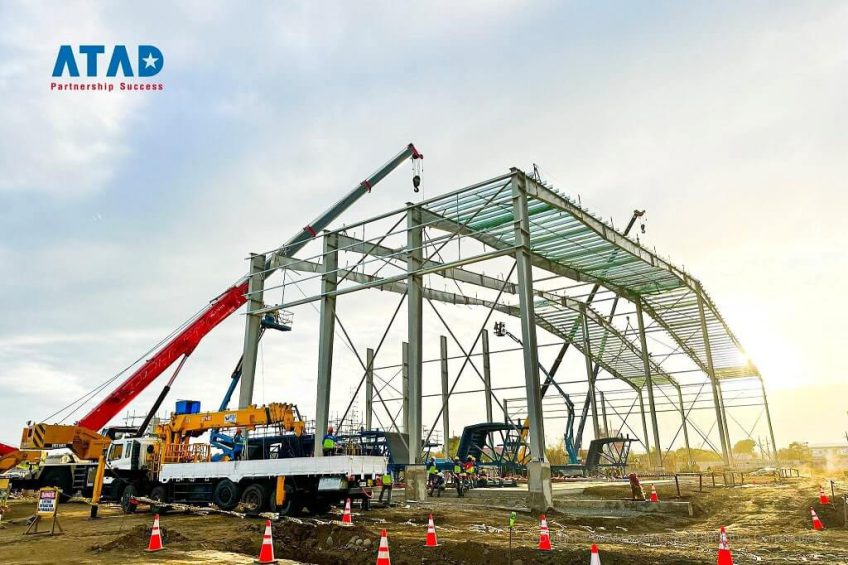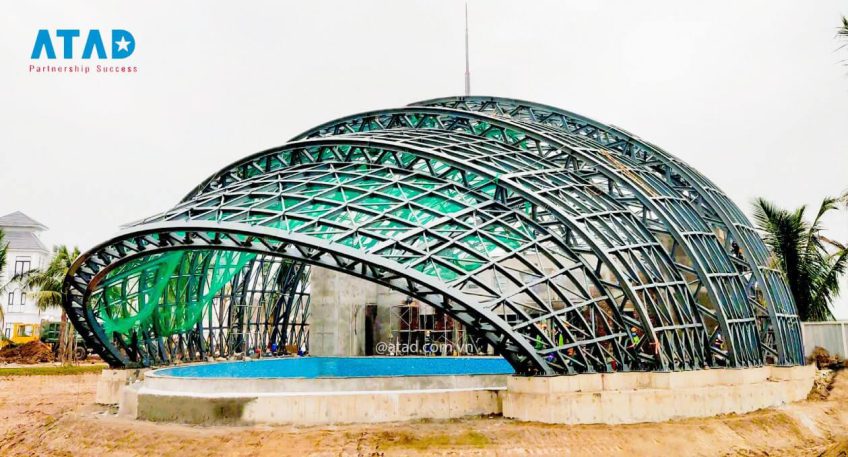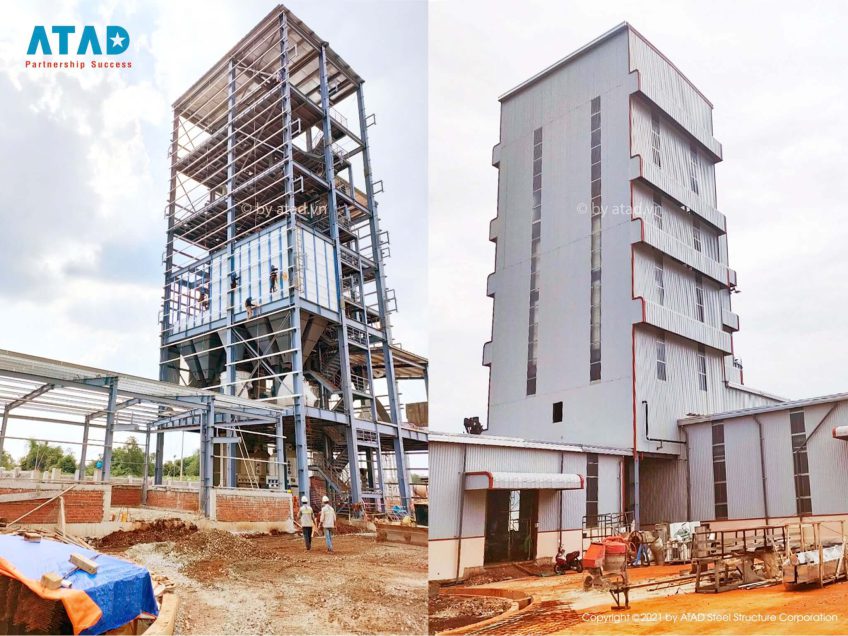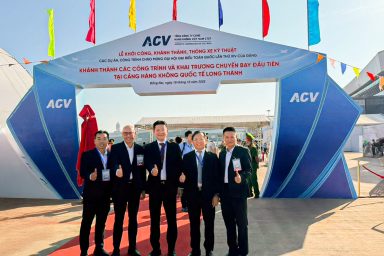Steel structures are constructions built with a steel frame to provide strength and support for buildings. Nowadays, due to numerous advantages (such as strength, durability, flexibility, etc.), steel structures are becoming increasingly popular in construction.
Common Types of Steel Structures
There are various types of steel structures currently being constructed and applied. Each type is designed differently to meet the diverse needs of clients. Below are some common types of steel structures:
Steel Frame Structures
This is the most common type of steel structure used in many buildings, from high-rise offices to residential homes. A steel frame structure consists of vertical steel columns, horizontal steel beams, and steel connections that link the components together. The beams and columns are connected by welding or bolting, creating a solid and stable structure.
Advantages:
- The structure can be assembled quickly, reducing construction time and labor costs.
- This type of structure is lighter, and the foundation process is simpler compared to concrete structures.
- Additionally, steel is a sustainable and recyclable material, making steel frame structures environmentally friendly.
DisAdvantages:
- Steel frame structures may be more expensive than other construction methods.
- The construction process requires careful planning and design to ensure structural integrity.
- The energy efficiency of the building may be affected if it is not properly insulated.
Steel Truss Frame Structures
Steel truss frame structures employ a series of interconnected triangles to evenly distribute weight across the entire structure. This type of structure is often used for roofs and bridges, and it can also be applied in constructions that require long spans.
Advantages:
- This structure type is lightweight and requires fewer materials than other structural types, helping to save costs.
- The construction is also easy to assemble, reducing construction time and labor costs.
- This structure is durable and can withstand harsh environmental conditions such as strong winds and earthquakes.
DisAdvantages:
- Designing and constructing frame structures is more complex compared to other types of buildings.
- These structures require careful maintenance to prevent corrosion and other time-related wear and tear.
- Modifying or expanding the structure is difficult, which may limit its future usage flexibility.
Steel arch structures
Steel arch structures are used in bridges and buildings that require long spans. This type of structure consists of a steel arch formed from a series of interconnected steel components shaped into a curve that supports the weight of the structure.
Advantages:
- The structure can span long distances without the need for intermediate supports, making it very suitable for bridges and structures crossing rivers or valleys.
- It is lightweight and requires less material than other types of structures, contributing to construction cost savings.
- Steel arch structures are durable and can withstand harsh environmental conditions such as strong winds and earthquakes.
- The space beneath the arch allows engineers easy access for maintenance and repairs.
DisAdvantages:
- Constructing this type of structure is relatively more complex than others, requiring considerable experience and modern equipment.
- Careful maintenance is necessary to prevent corrosion and deterioration.
- The difficulty in modifying or expanding the structure limits its future flexibility.
Steel cable structures
Steel cable structures utilize steel cables to support the framework, creating a suspension system typically used in the construction of suspension bridges or roofs. This structure comprises steel cables anchored to towers or columns at both ends of the construction. The cables are then tensioned across the span of the structure to form a suspension system for support. The cables can also be anchored to the ground or concrete blocks to enhance stability.
Advantages:
- The structure can be extended over long distances without the need for intermediate support, making it highly suitable for applications in constructing bridges and structures spanning rivers or valleys.
- Cable structures are lightweight and require less material compared to other structures, contributing to construction cost savings.
- Steel cable structures are durable and can withstand harsh environmental conditions.
- Maintenance of the structure is relatively easy, as the cables can be inspected and replaced simply.
DisAdvantages:
- Constructing the structure is relatively more complex than other structures, requiring considerable experience and modern equipment.
- The structure requires careful maintenance to prevent corrosion and damage.
Steel Space Frame Structures
Steel space frame structures utilize a three-dimensional frame of steel pipes to support the structure. They are commonly used in large projects such as airports and sports arenas. The space frame structure consists of a series of interconnected steel tubes welded together to create a three-dimensional framework. This frame is then covered with roofing and cladding materials to form a complete structure.
Advantages:
- The structure can be extended over long distances without the need for intermediate support, making it highly suitable for applications in constructing bridges and structures spanning rivers or valleys.
- Cable structures are lightweight and require less material compared to other structures, contributing to construction cost savings.
- Steel cable structures are durable and can withstand harsh environmental conditions.
- The maintenance of the structure is quite easy as the framework can be readily inspected and repaired.
DisAdvantages:
- Constructing the structure is relatively more complex than other structures, requiring considerable experience and modern equipment.
- The structure needs to be carefully maintained to avoid corrosion and damage.
- The structure is difficult to modify or expand, which limits future flexibility.
Light Steel Structure
Light steel structures utilize lightweight steel frames for support, commonly used in residential buildings and small commercial properties. The light steel structure consists of steel frames that are cold-formed into C or Z-shaped components. These components are assembled together using screws or bolts.
Advantages:
- The structure can be easily assembled, contributing to reduced construction time and labor costs.
- It is lightweight, and the foundation construction is simpler compared to concrete structures.
- Lightweight steel material is considered sustainable, as it can be easily recycled, making it an environmentally friendly choice.
- Light steel constructions are also easily maintained and replaced.
DisAdvantages:
- Thin steel frames may not be suitable for high-load buildings or long spans, as thin steel sheets lack sufficient strength.
- Although fire-resistant coatings and materials can be added during construction to improve the fire resistance of the structure, the overall fire resistance is generally lower than that of other building constructions.
Pre-Engineered Steel Structure
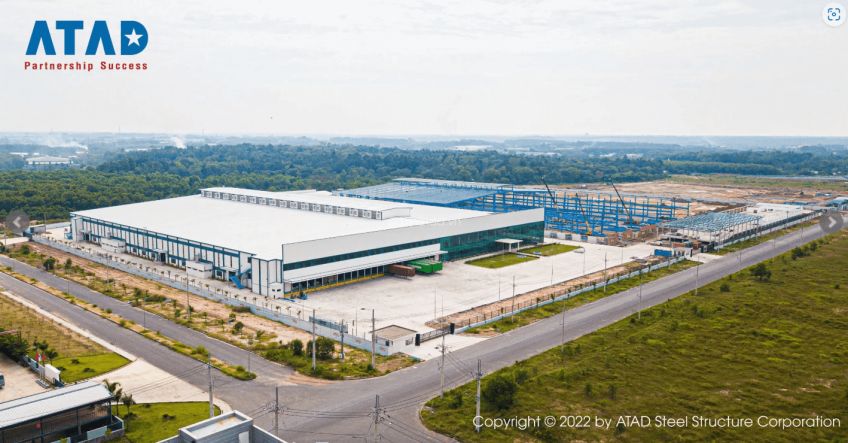
Pre-Engineered Steel Building – VPIC Project
The pre-engineered steel structure involves construction using standardized prefabricated components that are assembled on-site. It is commonly used for industrial projects such as factories, warehouses, and distribution centers. The pre-engineered steel structure includes standardized components like columns, beams, purlins, and steel girders designed for easy assembly.
Advantages:
- The structure can be assembled easily and quickly, contributing to saving time and construction costs.
- Standardized steel components result in more cost-effective solutions compared to custom structures.
- Buildings can be designed to meet specific requirements such as load-bearing capacity, insulation, or resistance to environmental factors.
- Pre-engineered steel structures are quite durable and can withstand harsh environmental conditions like strong winds, earthquakes, and fires.
- Pre-engineered steel buildings can be easily maintained, replaced, or resized.
Dis Advantages:
- Due to the standardized dimensions, it can be difficult for the structure to meet particular requirements of specialized buildings.
- Standardized components may limit the flexibility of custom designs.
- Aesthetically, pre-engineered steel structures may not achieve the same visual appeal as other types of construction.
This concludes some information on common types of steel structures in the construction industry. We hope this article has provided you with useful insights.










